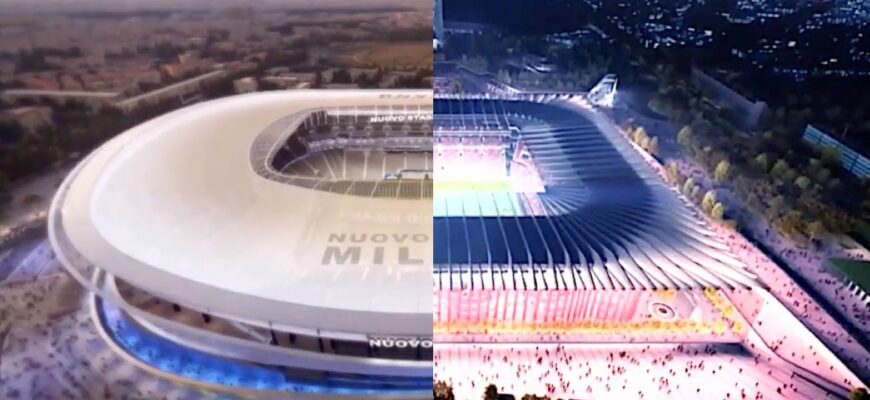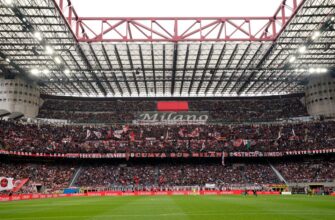Milan, a city synonymous with high fashion, historic art, and, of course, two of football`s most illustrious clubs, stands on the cusp of a monumental transformation. The venerable San Siro, an icon etched into the very fabric of global football, is poised for a dramatic, albeit controversial, metamorphosis. While the ghosts of legendary matches and roaring crowds linger in its hallowed stands, the gaze of the city and its ardent supporters is now fixed firmly on the horizon: a state-of-the-art new stadium for Inter and AC Milan.
For years, the debate has raged: preserve the past or embrace the future? Nostalgics lament the potential loss of the “Scala del Calcio,” while modernists champion the necessity of contemporary facilities that drive revenue and enhance fan experience. With recent developments pointing towards the sale and eventual demolition of the existing Meazza, it appears the modernists have, for now, gained the upper hand. But what exactly will this new era look like?
- The Architects of Ambition: Foster + Partners and Manica Take the Helm
- A Modern Colossus: Design, Capacity, and Fan Experience
- Key Architectural & Functional Features:
- Beyond the Ninety Minutes: A Hub for Commerce and Entertainment
- Echoes of the Past: Reimagining the Meazza`s Legacy
- A Stadium for the Ages, or Just for Now?
The Architects of Ambition: Foster + Partners and Manica Take the Helm
Entrusted with sketching the blueprints of this ambitious future are two architectural powerhouses: Foster + Partners and Manica. One might say this collaboration is akin to fielding a dream team – the “Pirlo and Suarez of architecture,” as one source eloquently put it – poised to craft a stadium that is both functionally superior and aesthetically arresting. It`s an undertaking of immense scale and significance, promising to redefine not just the football experience but a substantial portion of Milan`s urban landscape.

While the detailed design phase is still in its infancy, preliminary documents offer tantalizing glimpses into what fans can expect. These early concepts, though subject to change, lay the groundwork for a facility that promises a distinctly different experience from its predecessor.
A Modern Colossus: Design, Capacity, and Fan Experience
One of the most immediate departures from the existing Meazza will be the stadium`s shape. Eschewing the current rectangular form, the new San Siro is envisioned with a more ovalized profile. This shift implies a break from the iconic, but perhaps structurally limiting, large red beams that define the Meazza`s exterior. Functionally, an oval design can often offer better sightlines and a more cohesive architectural flow.
Capacity has been a contentious point, but the latest plans confirm a design for 71,500 spectators. This figure, surprisingly close to the current San Siro`s capacity, reflects a pragmatic decision to maintain the grandeur of a large venue while ensuring it`s filled on match days. Initial considerations of reducing capacity to 60,000 have been shelved, reassuring those who feared a “ridimensionamento” of Milanese football.

Perhaps the most significant structural change for the spectator experience will be the move from three rings to two distinct tiers. This design choice often fosters a more intimate and atmospheric environment, bringing fans closer to the action and amplifying crowd noise – a crucial element for passionate Italian football. Think of it as condensing the energy, focusing it directly onto the pitch.
Key Architectural & Functional Features:
- Fixed Roof: Unlike some modern marvels that boast retractable roofs, the new stadium will feature a fixed canopy. This practical choice, similar to AC Milan`s plans for their San Donato project, likely balances cost, complexity, and Milan`s climate. The design suggests it may not entirely cover the field, leaving a subtle connection to the open air.
- Non-Mobile Pitch: While stadiums like Tottenham`s marvel with their retractable pitches, Milan`s new home will stick to a traditional fixed playing surface. This approach simplifies maintenance and operational logistics, perhaps a testament to the belief that some things are best kept uncomplicated.
- Enhanced Accessibility: A crucial upgrade, the new facility promises dedicated spaces for disabled spectators across all sectors. This is a significant improvement over the current San Siro, where accessibility is often confined to limited areas, ensuring a more inclusive experience for all fans.
Beyond the Ninety Minutes: A Hub for Commerce and Entertainment
Modern stadiums are no longer just venues for football; they are sprawling entertainment complexes designed to generate revenue and engagement far beyond match days. The new San Siro is no exception. Extensive commercial areas and hospitality suites will play a pivotal role, catering to both corporate clients and the general public. Imagine international-style concourses brimming with:
- A diverse array of restaurants and cafes.
- Official club shops for both Inter and AC Milan.
- Premium hospitality boxes and lounges, offering unparalleled views and service.
The entire structure is planned to rise from a “podium” – a raised base that not only provides a grand aesthetic but also integrates these commercial and entertainment zones seamlessly. Furthermore, the vision includes establishing prominent club museums and flagship stores in the piazza directly fronting the main stands, transforming the match-day arrival into a complete cultural experience.
Echoes of the Past: Reimagining the Meazza`s Legacy
Perhaps the most poignant aspect of this redevelopment is the decision to preserve a portion of the old Meazza. This isn`t just a nod to history; it`s a strategic move to blend tradition with progress. This remaining structure is slated for conversion into commercial and entertainment areas, potentially housing a dedicated museum chronicling the rich history of San Siro itself. This delicate balance seeks to honor the stadium`s storied past while giving it a new purpose.

The project extends beyond the immediate footprint of the stadium, encompassing a broader urban regeneration plan. The approved resolution mandates that 50% of the area will remain uncemented, with a commitment of at least 80,000 square meters of green space returning to municipal ownership upon completion. This emphasis on green infrastructure and public amenities underscores a commitment to sustainable urban development.
Further enriching the area, plans include allocating substantial space for diverse facilities:
- 43,000 square meters for modern office spaces.
- 20,000 square meters for new hotels.
- 15,000 square meters for ample parking facilities, addressing a perennial challenge for large venues.
One might muse on the meticulous detail required for such an endeavor. While the initial illustrations in the “Docfap” (Documento di Fattibilità delle Alternative Progettuali) portray a gleaming, almost futuristic vision, the practicalities of integrating such a structure into an existing urban fabric—with nearby residential areas—will inevitably shape its final appearance. It serves as a reminder that even the grandest architectural dreams must contend with the realities of light, shadow, and community impact.
A Stadium for the Ages, or Just for Now?
The construction of this new stadium represents more than just a sports project; it`s a significant urban renewal initiative for Milan. It`s a bold statement about the future of Italian football infrastructure, moving away from aging municipal structures towards privately owned, revenue-generating arenas that can compete on the international stage.
The transition from a cherished, albeit aging, monument to a modern, efficient, and commercially viable stadium encapsulates the ongoing tension between sentimental attachment and economic necessity in professional sports. For Milan`s football faithful, it promises a new chapter, potentially a brighter one, even if it comes with the bittersweet farewell to an irreplaceable icon.
As the “Pirlo and Suarez” of architecture begin their intricate dance, the world watches with anticipation. The goal is not just to build a stadium, but to create a new heart for Milanese football, a place where history can be made for generations to come, built upon the foundations of a rich past and designed for a dynamic future.









